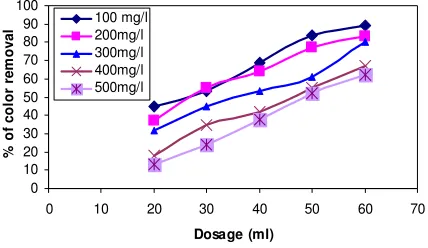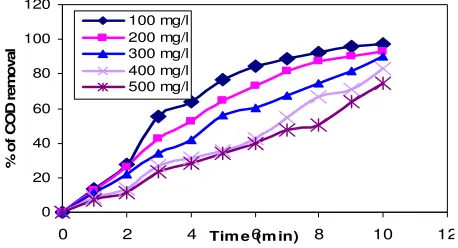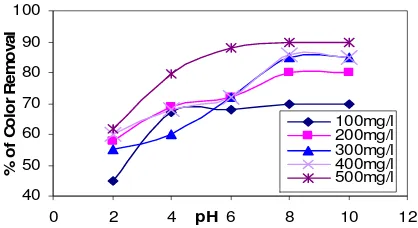REMOVAL OF REACTIVE YELLOW DYE FROM AQUEOUS
SOLUTIONS BY USING NATURAL COAGULANT (MORINGA
OLEIFERA)
Veeramalini J.B.1*, Sravanakumar. K2 and Joshua Amarnath. D3
1
P.G Student, Department of Environmental Engineering, Sathyabama University, Chennai, INDIA.
2,3
Department of Chemical & Environmental Engineering, Sathyabama University, Chennai, INDIA
E-mail: [email protected] (*Corresponding Author)
Abstract: Dyes are the main pollutants existing in wastewater of textile
industries. Dyes are produced naturally or artificially and can cause fabrics
to take different colors. In this paper the ability of natural products in
removing dyes has been tested. After a preliminary screening for dye
removal capacity, a vegetal protein extract derived from Moringa oleifera
seed have been fully studied. The influences of several parameters such as
pH, temperature or initial dye concentration have been tested and the
behavior of coagulants has been compared. pH results to be an interesting
variable and dye removal decreases as pH increases. Temperature seems
not to be so affecting parameter, while initial dye concentration appears to
be a very important variable in qc capacity, which is higher as IDC
increases. Langmuir isotherm model fits very well in M. oleifera seed
extract dye removal.
Keywords: Colour removal; coagulant; Textile wastewater: Moringa
oleifera: Dye
1. INTRODUCTION
Textile wastewater as one of the most polluted sources has been rather difficult to
Reactive dyes have been a great concern for protecting the water ecosystem because many
azo dyes and their breakdown products have been found toxic to aquatic life,
mutagenic/carcinogenic and gentoxic[1]. The activated sludge, coagulation and
flocculation processes and their combination are widely used in textile wastewater
treatment. However, aerobic biological treatment is not sufficient to break down azo
double bonds of reactive dyes which cause the colour problem in the effluent, while
coagulation process is only able to absorb them up to some extent but the sludge produced
from both processes becomes more difficult to be disposed off.
In aqueous solution, anionic dyes carry a net negative charge due to the presence
of sulphonate (SO3_) groups, while cationic dyes carry a net positive charge due to the
presence of protonated amine or sulfur containing groups [2]. Due to their strong
interaction with many surfaces of synthetic and natural fabrics, reactive dyes are used for
dyeing wool, cotton, nylon, silk, and modified acrylics.
Many treatment methods have been adopted to remove dyes from wastewater,
which can be divided into physical, chemical, and biological methods [3]. Although
chemical and biological methods are effective for removing dyes, they require specialized
equipment and are usually quite energy intensive; in addition, large amounts of
by-products are often generated. Generally, physical methods which include adsorption, ion
exchange, and membrane filtration are effective for removing reactive dyes without
producing unwanted by-products [4].
Several methods are used to treat coloured effluents to achieve decolourization.
These include physicochemical methods such as filtration, coagulation, use of activated
carbon and chemical flocculation [5, 6]. These methods are effective but they are
expensive and involve the formation of a concentrated sludge that creates a secondary
disposal problem which requires safe disposal.
The objective of the present study was to examine the decolourization of the
Reactive Yellow 145 by under static conditions and in the determination of the effect of
2. Materials and Methods
2.1 Preparation of coagulant
The husk covering the M. oleifera seeds were manually removed, good quality seeds
were selected, and the kernel was ground to a fine powder using an ordinary electric
blender. The active component from coagulant was extracted using sodium chloride (NaCl)
or potassium chloride (KCl) salt solution. A concentration of 4% (4 g of powder in 100ml
salt solution) was used throughout the study after several trials. The whole mixture was
stirred for 30 min at room temperature using a magnetic stirrer. The suspension was
filtered using whatman filter paper. The resultant filtrate solution was used as a coagulant.
A fresh solution was prepared every day for reliable results.
2.2 Coagulation Studies
The coagulation studies were performed using Jar test apparatus which allowed
for six 1 litre beakers to be agitated simultaneously and rotational speed could be varied
between 0 and 100 rotations per minute (RPM). The beakers were filled with 1000ml dye
sample. During rapid mixing at 100RPM for 2 min coagulant dosage was added into each
beaker and was followed by slow mixing at 40RPM for 30min. The duration of
sedimentation was kept constant at 30 min. The supernatant after sedimentation was
filtered using whatman filter paper. The filtrate was analyzed for absorbance using
UV-spectrophotometer at a maximum wavelength 526.5 nm. Color removal efficiency was
measured as a decrease in optical density measurement at 475 nm. The readings were taken
in triplicate for each individual solution to check repeatability.
RESULTS AND DISCUSSION
Dye characterization
The acidity constants (Ka) for these particular dyes have not been previously
reported. The values of pKa of the reactive dyes were determined using a standard
potentiometric titration method. Due to their acidebase properties, dyes can be titrated
using suitable acid or base solution. The pKa values of reactive dyes were calculated by
Table 1 summarizes the number of polar and ionizable functional groups that were
present in dye molecules and contain much the same density of polar functional groups
(15-18 groups/molecule) and ionizable groups (3-4 groups/molecule) [7.8].
Table.1. Characteristics of Reactive Yellow Dye 2
C.I generic
Effect of coagulant dose on coagulation:
Different concentrations such 100, 200, 300, 400 or 500 mg Moringa oleifera
was added to a 1000 ml textile waste water sample (figure.1). After rapid mixing for 5 min
at 200 rpm and slow mixing for 55 min at 60 rpm, the sample was withdrawn by using a
plastic syringe from a point about 2 cm below the top of liquid level at the beaker in order
to determine the COD and colour, so that the effect of coagulant dose on coagulation could
be studied. For the purpose of coagulation, pH was adjusted to 8.5 by addition of Ca(OH)2.
0
Fig. 1: Effect of coagulant dose on the removal of Color
EFFECT OF CONTACT TIME
The preceding section discussed the effect of contact time on the degradation of
vs % of removal. The typical graph represents constant dose 0.20g under room temperature
was maintained at natural pH of variable concentration.
Figure 2. Effect of contact time on decolorization- Reactive yellow dye by Moringa
oleifera.
Effect of pH
The Effect of pH was one of the parameters was crucial to determine the optimum level
in order to minimize the dosing cost and obtain the optimum performance in treatment.
The aqueous solution of dyes having concentration of 100 mg l-1 were treated by varying
constant concentration of 0.20 g dose of adsorbent for half an hour with varying pH 2 to 10.
The pH was maintained with the help of 0.1 N-HCl and 0.1 N-NaOH solutions. pH
variation in comparison had a significant effect on the decolorization of Reactive yellow
by Moringa oleifera. Figure 2 shows that the highest color removal was detected in pH 10
(93%). The removal of dyes are more at higher pH, because the surface of activated
coagulants are negatively charged, the decrease in adsorption capacity in the low pH region
would be expected as the acidic medium would lead to an increase in hydrogen ion
concentration which would then neutralize the negatively charged coagulant surface
thereby decreasing the adsorption of the positively charged caution because of reduction in
Figure 3. Effect of various pH on decolorization- Reactive yellow dye by Moringa
oleifera.
Conclusion
Coagulation process was used to treat textile dye effluent. Results of the
experiments revealed the following: 500mg Moringa oleifera reduces COD and color by
37 and 62% respectively. The pH range of 8-10 was found to be effective for the
coagulation process. Increasing dosage increases the enhancement of removal of
contaminants. Temperature effect on the removal of COD from the textile dye effluent
during cogulation process was negligible. 1000mg coagulant enhances efficient removal of
COD and color in the coagulation process.
REFERENCES
[1] A. Olsen, Low technology water purification by bentonite clay and Moringa oleifera
seed flocculation as performed in Sudanese village: effects on Schistosoma Mansoni
cercariae, Water Res. 21 (1987) 517-522.
[2] Chaudhari, S., Baes, A.U., Nishijima, W., Okada, M., 2001b. Isolation and
characterization of coagulant extracted from Moringa oleifera seed by salt solution.
[3] Muyibi, S.A. and Alfugara, A.M.S. (December 2003). Treatment of surface water with
Moringa oleifera seed extract and Alum - A comparative study using A Pilot scale
water treatment plant. International Journal of Environ. Studies, Vol. 60, No. 6, pp.
617-626
[4] Okuda, T., Baes, A.U., Nishijima, W., and Okada, M. (1999). Improvement of
Extraction method of coagulation active components from Moringa oleifera Seed.
Water Res., Vol. 33, No. 15, pp. 3373-3378.
[5] Folkard, G.K., Sutherland, J.P., and Grant, W.D. (1992). Natural coagulants as pilot
scale. 18th WEDC Conf. Proceedings, pp. 55-58.
[6] A. Ndabigengesere, S. Narasiah, Quality of water treated by coagulation using
Moringa olifera seeds, Water Res. 32 (3) (1998) 781-791.
[7] Madsen, M., Schlundt, J. and E.F. Omer (1987). Effect of water coagulation by seeds
of Moringa oleifera on bacterial concentrations. Journal of Tropical Medicine and
Hygiene; 90(3): 101-109
[8] Nkurunziza, T., Nduwayezu, J. B., Banadda E. N. and I. Nhapi (2009). The effect of
turbidity levels and Moringa oleifera concentration on the effectiveness of
coagulation in water treatment. Water Science & Technology, Vol 59, No 8, pp 1551-
1558.


